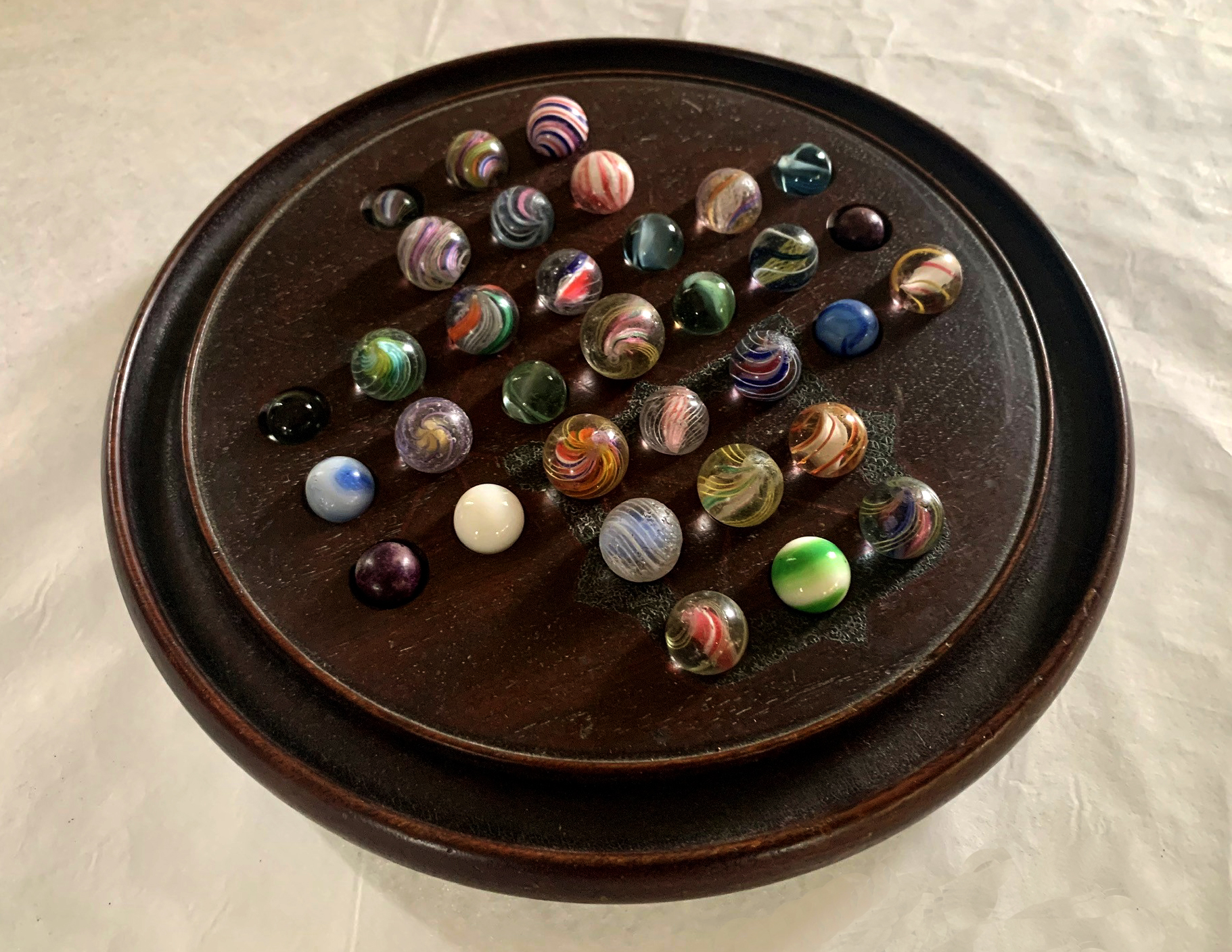Marble Solitaire
Marble Solitaire
By Carrie Crane

Earlier this spring there was a brief online kerfuffle that started with Tom Hanks exclaiming in a Wall Street Journal piece that he would never play solitaire again. He had come to see it as a time-wasting habit he had picked up during the pandemic. Many others however were quick to respond in support of the game as a great way to relax and gently challenge the brain. And this appears to have been true for a very long time.
The word “solitaire” as we use it in the United States refers collectively to a number of single player card games. In England and Europe however, the word refers to a game known as either Peg Solitaire or Marble Solitaire. This is also a single player game but involves a board and a number of moving pegs or marbles. The game dates back to at least 1687 and a Claude Auguste Berey etching from that year. The image depicts the Princess of Soubise, at one time the Mistress of Louis the XIV, playing the French 37-hole version of the game. The modern English or German, a 33-hole version, like the one shown above, is referenced as early as 1779 and its development is attributed to nuns and monks who used it as a way to entertain themselves in their solitary monastic life.
Displayed here are some of the layout variations found for peg solitaire with the most popular being (1) the French version and (4) the English and German version.

By Júlio Reis - Peg Solitaire game board shapes.png by Wolfgang, W. Peg solitaire game board shapes:
(1) French (European) style, 37 holes, 17th century;
(2) J. C. Wiegleb, 1779, Germany, 45 holes;
(3) Asymmetrical 3-3-2-2 as described by George Bell, 20th century;
(4) English style (standard), 33 holes;
(5) Diamond, 41 holes;
(6) Triangular, 15 holes. Grey = the hole for the survivor.
The Boylston Historical Society Museum’s Marble Solitaire board shown above was donated to the Society by Norman French. It was passed down to him from his grandmother, Mary Elizabeth (Andrews) French, when he was young and likely dates back to the 1870’s. This circular board has a 9 ¾” in diameter and is likely made from a single piece of solid mahogany hardwood and turned on a lathe. It has 33 indentations in a cross pattern to hold the playing pieces, in this case glass marbles. While there are 33 spaces, the game is played with 32 marbles, as the central spot is left empty to begin the game. A new game would have come with a set of marbles all of the same size and quality, so it is likely that some of the marbles seen here are substitutes for the originals.
The game is played in a similar fashion to checkers. A piece is eliminated by jumping one piece over another and removing it. Vertical and horizontal moves are allowed but not diagonal ones. The goal of the classic 33-hole game of solitaire is to start with the center hole empty and end with all but one piece left which lands back in that center hole. There are numerous ways to reach this goal but the shortest solution involves only 18 moves (multiple jumps with one piece count as one move). This particular solution to the game was first noted in 1912 and was confirmed in 1964 by game theorist John Beasley to be the shortest possible solution. Beasley and a surprisingly large number of other mathematicians have written extensively about this game. You can find lessons, solutions and the mathematical proofs for those solutions in his book for mathematical game enthusiasts, “The Ins and Out of Peg Solitaire (Recreations in Mathematics)” published in 1985 or in multiple places on the world wide web. You will be able to also access the series of moves for the 18-step solution and feel like a pro right off the bat.
___________
Acknowledgements:
Editor: Nancy Filgate, Boylston Historical Society & Museum
Photographer: Suzanne Martiska, Boylston Historical Society & Museum
http://recmath.org/pegsolitaire/
http://recmath.org/pegsolitaire/papers/Beasley_AnUpdatetotheHistoryofPegSolitiare.pdf
https://en.wikipedia.org/wiki/Peg_solitaire
https://commons.wikimedia.org/w/index.php?curid=1271918
